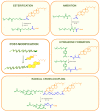Polymeric Drug Delivery Systems Bearing Cholesterol Moieties: A Review
- PMID: 33172152
- PMCID: PMC7694753
- DOI: 10.3390/polym12112620
Polymeric Drug Delivery Systems Bearing Cholesterol Moieties: A Review
Abstract
This review aims to provide an overview of polymers comprising cholesterol moiety/ies designed to be used in drug delivery. Over the last two decades, there have been many papers published in this field, which are summarized in this review. The primary focus of this article is on the methods of synthesis of polymers bearing cholesterol in the main chain or as side chains. The data related to the composition, molecular weight, and molecular weight distribution of polymers are presented. Moreover, other aspects, such as forms of carriers, types of encapsulated drugs, encapsulation efficiency and capacity, are also included.
Keywords: cholesterol; drug delivery; drug encapsulation; encapsulation capacity; encapsulation efficiency; polymers comprising cholesteryl moiety.
Conflict of interest statement
All authors declare no conflict of interest.
Figures







Similar articles
-
Thermally responsive polymeric micellar nanoparticles self-assembled from cholesteryl end-capped random poly(N-isopropylacrylamide-co-N,N-dimethylacrylamide): synthesis, temperature-sensitivity, and morphologies.J Colloid Interface Sci. 2003 Oct 15;266(2):295-303. doi: 10.1016/s0021-9797(03)00691-x. J Colloid Interface Sci. 2003. PMID: 14527452
-
Improving drug biological effects by encapsulation into polymeric nanocapsules.Wiley Interdiscip Rev Nanomed Nanobiotechnol. 2015 Sep-Oct;7(5):623-39. doi: 10.1002/wnan.1334. Epub 2015 Jan 30. Wiley Interdiscip Rev Nanomed Nanobiotechnol. 2015. PMID: 25641603 Review.
-
Elastin-Like Recombinamers As Smart Drug Delivery Systems.Curr Drug Targets. 2018 Feb 19;19(4):360-379. doi: 10.2174/1389450117666160201114617. Curr Drug Targets. 2018. PMID: 26844559 Review.
-
Polymeric micelles for drug targeting.J Drug Target. 2007 Nov;15(9):553-84. doi: 10.1080/10611860701538586. J Drug Target. 2007. PMID: 17968711 Review.
-
Cholesteryl to improve the cellular uptake of polymersomes within HeLa cells.Int J Pharm. 2016 Sep 10;511(1):570-578. doi: 10.1016/j.ijpharm.2016.07.036. Epub 2016 Jul 22. Int J Pharm. 2016. PMID: 27452422
Cited by
-
A novel avenue in the successful synthesis of Schiff base macromolecules via innovative plasma and classical approaches.Sci Rep. 2025 Mar 29;15(1):10840. doi: 10.1038/s41598-025-94665-z. Sci Rep. 2025. PMID: 40155415 Free PMC article.
-
Advancements in understanding the role of microRnas in regulating macrophage polarization during acute lung injury.Cell Cycle. 2023 Jul-Aug;22(14-16):1694-1712. doi: 10.1080/15384101.2023.2230018. Epub 2023 Jul 6. Cell Cycle. 2023. PMID: 37415386 Free PMC article. Review.
-
Charge-Convertible and Reduction-Sensitive Cholesterol-Containing Amphiphilic Copolymers for Improved Doxorubicin Delivery.Materials (Basel). 2022 Sep 18;15(18):6476. doi: 10.3390/ma15186476. Materials (Basel). 2022. PMID: 36143789 Free PMC article.
-
An effective antimicrobial complex of nanoscale β-cyclodextrin and ciprofloxacin conjugated to a cell adhesive dipeptide.RSC Adv. 2022 Dec 15;12(54):35383-35395. doi: 10.1039/d2ra05822g. eCollection 2022 Dec 6. RSC Adv. 2022. PMID: 36544467 Free PMC article.
-
Tuning Hyaluronic Acid Microstructures by Engineered Amphiphilicity: From Dynamically Cross-Linked Gels to Multilayered Nanoparticles.ACS Appl Mater Interfaces. 2025 Jun 4;17(22):31909-31922. doi: 10.1021/acsami.5c04736. Epub 2025 May 25. ACS Appl Mater Interfaces. 2025. PMID: 40415248
References
-
- Jelonek K., Kasperczyk J. Polyesters and polyester carbonates for controlled drug delivery. Part II. Implantable systems. Polimery. 2013;58:858–863. doi: 10.14314/polimery.2013.858. - DOI
-
- Jones D. Pharmaceutical Applications of Polymers for Drug Delivery. Rapra Technology; Shrewsbury, UK: 2004. Rapra Review Reports.
-
- Nakielski P. Drug Release Systems Based on Nanofibers. IPPT PAN; Warsaw, Poland: 2015. IPPT Reports on Fundamental Technological Research.
Publication types
Grants and funding
LinkOut - more resources
Full Text Sources

